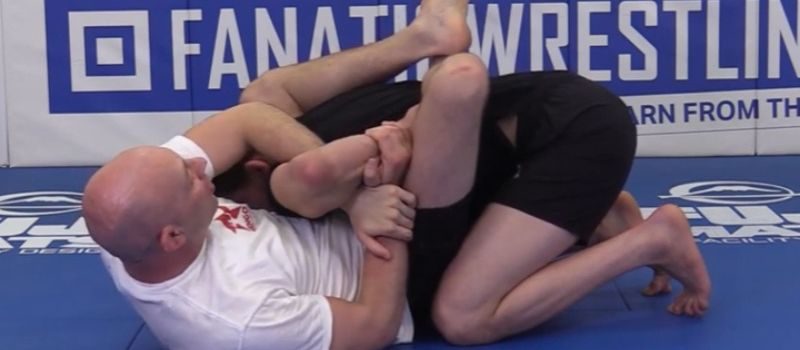History of the Kimura Lock
The Kimura Lock is a highly effective kimura submission in the world of grappling martial arts. Named after the legendary Japanese judoka Masahiko Kimura, this technique has become a staple kimura jiu jitsu move in the arsenal of many fighters. The history of the Kimura Lock dates back to the mid-20th century when Helio Gracie, the founder of Brazilian Jiu-Jitsu, faced off against Kimura himself in a historic match.

Understanding the Mechanics
To truly master the Kimura Lock, it is essential to understand the mechanics behind this powerful kimura hold. The Kimura Lock primarily targets the shoulder joint, applying a combination of leverage and control to immobilize and manipulate your opponent’s arm. By isolating the shoulder joint and applying torque, you can effectively force your opponent to submit or risk serious injury, which is the essence of how to do a kimura.
The beauty of the Kimura Lock lies in its versatility, with kimura submissions allowing it to be executed from various positions, including the guard, side control, and mount. Whether you are on top or bottom, the Kimura Lock, even in no gi kimura scenarios, offers you an opportunity to gain the upper hand and control the outcome of the match.
Common Setups for the Kimura Lock
Setting up the Kimura Lock requires careful positioning and timing. There are several common kimura setup techniques that you can utilize to catch your opponent off guard and secure the kimura move. One popular setup involves baiting your opponent into attempting a sweep or escape, only to transition into the Kimura Lock as they expose their arm. Another effective setup is to use the threat of a different submission, such as an armbar or triangle choke, to distract your opponent and create an opening for the Kimura Lock.

Helio Gracie vs Masahiko Kimura
One of the most iconic moments in kimura history occurred in 1951 when Helio Gracie faced off against Masahiko Kimura himself. Gracie, known for his smaller stature, was determined to prove the effectiveness of Brazilian Jiu-Jitsu against larger opponents. Despite his best efforts, Gracie eventually fell victim to Kimura’s superior technique and strength. The match ended with Gracie’s arm being broken by the devastating kimura armbar. This historic encounter showcased the power and effectiveness of the Kimura Lock, solidifying its place in martial arts history.
Executing the Kimura Lock from Different Positions
From the Guard
- Start in the closed guard, securing your opponent’s posture and controlling their arms.
- Break your opponent’s posture by pulling them forward and off-balance.
- Use your legs to create space and insert one arm under your opponent’s arm, gripping your own wrist.
- Lock your legs around your opponent’s back to prevent them from escaping.
- Apply pressure by lifting your hips and twisting your body towards your opponent’s trapped arm.
- Maintain control and increase the pressure until your opponent taps out or you achieve a dominant position.
From Side Control
- Establish a strong side control position, securing your opponent’s near arm.
- Transition to a north-south position, placing your chest on your opponent’s arm.
- Slide your arm under your opponent’s arm, gripping your own wrist.
- Use your body weight to apply downward pressure on your opponent’s shoulder.
- Keep your opponent’s arm trapped as you rotate your body towards their head.
- Apply torque and maintain control until your opponent submits or you transition to a more dominant position.
From Mount
- Achieve a dominant mount position, keeping your knees close to your opponent’s body.
- Control your opponent’s arms by gripping their wrists or sleeves.
- Slide one knee up towards your opponent’s head, creating space for your arm.
- Insert your arm under your opponent’s arm, gripping your own wrist.
- Apply downward pressure on your opponent’s shoulder while driving your knee towards their head.
- Maintain control and increase the pressure until your opponent taps out or you transition to a submission.

Countering Common Defenses against the Kimura Lock
As with any submission hold, the Kimura Lock is not foolproof and can be countered by a skilled opponent. It is essential to be aware of common kimura defense strategies and know how to counter them effectively. One common defense is for your opponent to stack their weight and try to roll out of the submission. To counter this, you can release the Kimura grip and transition to a kamora hold such as a back take or another submission hold.
Another defense against the Kimura Lock is for your opponent to grip their own shorts or belt, making it difficult to complete the kimura grip. In this situation, you can use your free hand to pry their grip open or transition to a different submission that exploits their exposed arm, effectively countering the kamora submission attempt.
Kimura Trap System
The Kimura Lock is not just a standalone submission hold, but also the cornerstone of the comprehensive Kimura System known as the Kimura Trap. The Kimura Trap System capitalizes on the threat of the Kimura Lock to manipulate your opponent’s movements and set up a diverse array of attacks and transitions, including the kimura choke. By delving into the complexities of the Kimura Trap, you can significantly elevate your grappling game and maintain an element of unpredictability against your adversaries.
Advanced Variations and Transitions
Once you’ve grasped the fundamentals of the Kimura Lock, you can delve into advanced kimura variations and kimura transitions to maintain the upper hand. Some sophisticated techniques include the reverse Kimura, rolling Kimura, and flying Kimura, all of which can be formidable kimura submission ufc techniques. These advanced maneuvers demand greater skill and precise timing but are designed to surprise and subdue even the most seasoned grapplers.
Executing transitions from the Kimura Lock can position you for other dominant holds and kamora bjj submissions, such as the kimura to armbar, triangle choke, or even a strategic back take, depending on how your opponent reacts. Integrating the Kimura Lock into a broader grappling approach allows you to fluidly shift from one technique to the next, bolstering your likelihood of triumph in the match.
Training Drills to Improve Your Kimura Lock Technique
To truly excel in the Kimura Lock, it’s imperative to engage in consistent kimura training and perform targeted kimura drills. These exercises are designed to refine your technique and enhance your proficiency in this submission hold.
- Solo drilling:
Practice the movements and mechanics of the Kimura Lock without a partner. Focus on proper grip placement, body positioning, and fluid transitions between positions. - Resistance drilling:
Partner up with a training partner and take turns applying and defending against the Kimura Lock. Start with low resistance and gradually increase the intensity as your skills improve. - Live rolling:
Incorporate the Kimura Lock into your sparring sessions and actively look for opportunities to apply the submission. Experiment with different setups and transitions, and learn from your successes and failures.
Bear in mind, achieving mastery in the Kimura Lock requires time, kimura practice, and a steadfast kimura dedication. A commitment to regular training and an openness to learning from errors are crucial for mastering this formidable submission technique.
Practical Applications in Different Grappling Disciplines
The Kimura Lock’s application extends beyond any single grappling style and can be effectively employed in various martial arts such as Brazilian Jiu-Jitsu, Judo, kimura wrestling, and Mixed Martial Arts (MMA). Its adaptability and potency render it an indispensable asset for both self-defense scenarios and competitive combat sports, earning its place in both kimura mma and kamora mma strategies.
In Brazilian Jiu-Jitsu, the bjj kimura is frequently utilized to dominate an opponent from the top position or to seamlessly transition into other submissions. In Judo, practitioners may employ the kimura judo technique as a counter to an adversary’s throw attempt or to secure and pin them to the mat. Wrestlers find the Kimura Lock a strategic move for asserting control and accruing points. Meanwhile, in MMA, numerous fighters have leveraged the kimura hold to clinch victories within the confines of the Octagon.
Tips for Integrating the Kimura Lock
To effectively integrate the Kimora bjj Lock into your overall grappling strategy, consider the following kimura tips:
- Develop a solid understanding of the fundamental positions and transitions that lead to the Kimura Lock. This will allow you to seamlessly flow from one technique to another and keep your opponents guessing.
- Study the setups and variations of the Kamura bjj Lock from different positions. By expanding your knowledge and repertoire, you can adapt to various scenarios and capitalize on your opponent’s weaknesses.
- Practice the Kamura Lock with a focus on technique and precision. It is better to execute the submission with proper form and control rather than relying solely on strength and athleticism.
- Experiment with the Kimura Lock during live training and sparring sessions. Take risks and learn from your successes and failures. This will help you refine your technique and develop a deeper understanding of the submission.
- Seek guidance from experienced instructors and training partners. They can provide valuable insights, correct your mistakes, and help you troubleshoot any difficulties you may encounter.
Conclusion
The Kimura Lock is a powerful and versatile submission hold that has stood the test of time. By understanding the history, mechanics, setups, and variations of the Kimura Lock, you can add this devastating technique to your grappling arsenal. With consistent training, drilling, and a strategic approach, you can achieve kimura mastery. Embrace the challenge, put in the work, and unlock your kimura potential on the mat.
FAQ's
Can the Kimura Lock break an arm?
Yes, the Kimura Lock has the potential to break an opponent’s arm if applied with sufficient force and resistance. It places tremendous pressure on the shoulder joint, and if the opponent does not tap out or submit, there is a risk of injury.
Is the Kimura Lock real?
Yes, the Kimura Lock is a real submission technique used in various grappling disciplines. It is named after Masahiko Kimura, a renowned Japanese judoka who popularized the technique in a match against Helio Gracie.
What does the Kimura Lock do?
The Kimura Lock primarily targets the shoulder joint and immobilizes the opponent’s arm. By applying leverage and control, it creates immense pressure on the shoulder, forcing the opponent to submit or risk injury.
Why is it called the Kimura Lock?
The Kimura Lock is named after Masahiko Kimura, a Japanese judoka who defeated Helio Gracie in a historic match in 1951. Kimura popularized the technique and showcased its effectiveness, leading to it being named after him.
Feel free to comment down there,what you think about this blog


